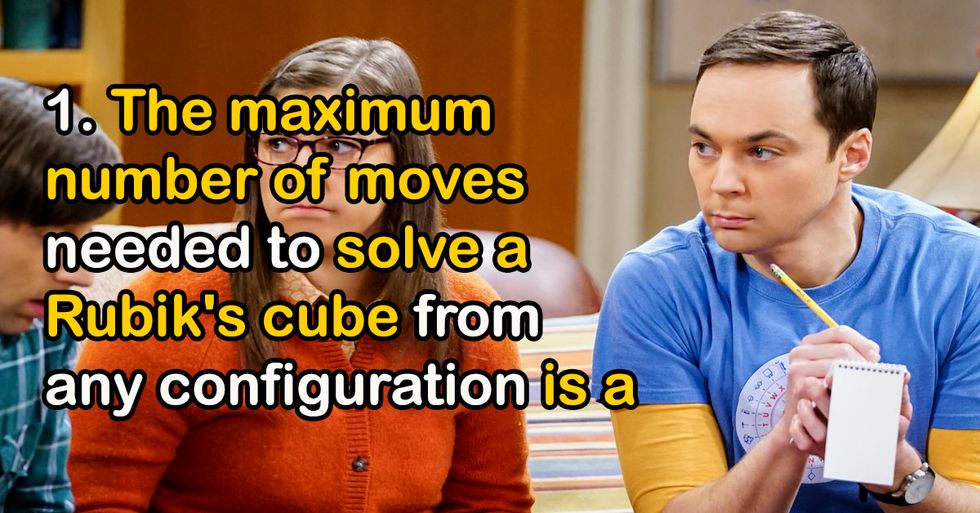Nerdy Geniuses Share The Most Interesting Mathematical Facts In Their Brains

Nerdy Geniuses Share The Most Interesting Mathematical Facts In Their Brains
[rebelmouse-image 18352979 is_animated_gif=Math Nerds, unite!
Chances are if you ask the average person about a math fact, the best they'll be able to come up with is "2+2=4." But not these Redditors. We all know math has to have some cool, complicated concepts, but how could we ever understand them?
Reddit user xxTick asked the masses:
Here are some answers that will make you reconsider those days you skipped intro to calc.
E, Eh?
[rebelmouse-image 18352980 is_animated_gif=e (2.718281828459045...) is the average number of random numbers between 0 and 1 that must be added to sum to at least 1.
Excitable Numbers
[rebelmouse-image 18352981 is_animated_gif=there are exactly 10! seconds in six weeks.
10! = 1 x 2 x 3 x 4 x 5 x 6 x 7 x 8 x 9 x 10 how many seconds in 6 weeks? 6 weeks x 7 days x 24 hours x 60 minutes x 60 seconds = (2 x 3) x 7 x ( 2 x 3 x 4) x (2 x 3 x 10) x (5 x 6 x 2) combine the 3's, combine the extra 2's, stick a 1 in front... = 1 x 2 x 3 x 4 x 5 x 6 x 7 x 8 x 9 x 10 seconds.
Classically Trained
[rebelmouse-image 18352982 is_animated_gif=Cantor's diagonal proof which implies more than one infinity. At least for classical mathematicians.
And Beyond
[rebelmouse-image 18352983 is_animated_gif=Gabriel's horn, the volume of the cone is finite, but the surface area is infinite.
Rumors Spread
[rebelmouse-image 18352984 is_animated_gif=As a PhD student in mathematics, this is not a sexy answer, but one of the reasons I fell in love with math was in my differential equations course when we discussed modeling epidemic using mathematical equations. It was so incredible to me that back in 1927, Kermack and McKendrick came up with a simple formulation of how to model a disease. This idea has been expanded greatly, but their original version of the S-I-R compartmental model is still one of the coolest things. And it can also model rumors as well!
Unsatisfied
[rebelmouse-image 18352985 is_animated_gif=I love Fermat's Last Theorem:
no three positive integers a, b, and c satisfy the equation an + bn = cn for any integer value of n greater than 2.
It just intuitively seems that some n should work, given infinite possible numbers, but it's been proven that nothing but 2 fits.
2D Life
[rebelmouse-image 18352986 is_animated_gif=If you take enough random steps in two dimensions, you'll always eventually get back to your starting point. The same cannot be said of three dimensions.
I just find the idea that you will always get back to where you started by making random moves absolutely mind boggling, and the fact things change just because you can go up and down is even weirder.
Imaginarium
[rebelmouse-image 18352987 is_animated_gif=ii = 0.20787957635
So an imaginary number to an imaginary power is a real number.
Jokes For Days
[rebelmouse-image 18352989 is_animated_gif=99999999999999999989 is the largest prime number that can also be a Reddit username.
Beep Booop Boop
[rebelmouse-image 18352991 is_animated_gif=1 x 1 = 1
11 x 11 = 121
111 x 111 = 12321
1111 x 1111 = 1234321
And on it goes
Algorithm
[rebelmouse-image 18352992 is_animated_gif=The maximum number of moves needed to solve a Rubik's cube from any configuration is a mere 20.
Expecting Numberphile subscribers to have a strong showing in this thread.
Belphegor's Prime
[rebelmouse-image 18352993 is_animated_gif=There is a prime number named after one of Satan's devils. It is a 1 followed by 13 0s. 666. 13 more 0s. And a 1.
Conjecture Lecture, What's Your Texture?
[rebelmouse-image 18352994 is_animated_gif=The Collatz Conjecture: It's an unsolved mathmatical conjecture that can be summarized as follows; Take any positive integer, or "n". If n is even, divide it by 2 to get n / 2. If n is odd, multiply it by 3 and add 1 to obtain 3n + 1. Repeat the process indefinitely. The conjecture is that no matter what number you start with, you will always eventually reach 1. For example, start with 21. it's odd so I multiply by 3 and add 1, to get 64. 64 is even so I divide by 2 to get 32, again to get 16, 8, 4, 2, 1. No one has found a number that doesn't follow this rule.
Birthday Drama
[rebelmouse-image 18352995 is_animated_gif=The Birthday Problem.
If you have 23 people in a room, there is a 50% chance that at least two of them have the same birthday. If you put 70 people in, the probability jumps to 99.9%.
It seems f-cking weird to me but I haven't done math since high school so what do I know.
Impossible Parchment
[rebelmouse-image 18352996 is_animated_gif=if you fold a piece of paper 103 times, the thickness of it will be larger than the observable universe - 93 billion light-years
The Ball
[rebelmouse-image 18352998 is_animated_gif=Banach-Tarski paradox, in a nutshell what it says is that if you take a (let's make it simpler) 3 dimensional ball, you can partition it in finite number of pieces (which is only true for 3-dim case, otherwise it's countably infinite) and then rotate and translate some of the pieces and you can get two exactly identical balls that we started with. So you might think we doubled the volume, indeed we did.
It's Everywhere To Me
[rebelmouse-image 18352999 is_animated_gif=Astronomer here! Do you remember a few months ago when NASA announced the discovery of seven Earth-sized planets around a star called TRAPPIST-1? Astronomers and mathematicians freaked out a bit about it because it turned out all those planets were in resonance, where objects orbit in a simple multiplicative of another (so, if Earth were to orbit the sun one time every time Venus orbited twice- not really the case). These simple ratios can be good in celestial mechanics for sure- Pluto crosses Neptune's orbit, for example, but they are in a 2:3 resonance so will never crash into each other. But it's also very likely to lead to amplified gravitational forces that then eject planets, and frankly, TRAPPIST-1 should not be stable based on the resonances we see there and is just very luckily in a few million year gap or so where that system can exist according to mathematics and computer simulations.
The cool thing about this though is resonance is a mathematical concept that just describes vibrations, from that in a violin string to stability in a bridge. And acoustic resonance is very important for making music sound good- some resonances work, some make music sound "bad."
The cool thing here though is because mathematics shows up in everything, some Canadian astronomers realized you can "hear" TRAPPIST-1 because it has "good" resonances. (No really, they tried other systems, but apparently they all sounded awful.) They sped up the orbits of the system 212 million times (so you wouldn't have to wait ~18 years to hear the full piece), and frankly the resulting piece is pretty awesome. You should check it out!
Math is everywhere!
Solitaire
[rebelmouse-image 18353000 is_animated_gif=One of my favorite is about the number of unique orders for cards in a standard 52 card deck.
I've seen a a really good explanation of how big 52! actually is.
Set a timer to count down 52! seconds (that's 8.0658x1067 seconds)
Stand on the equator, and take a step forward every billion years
When you've circled the earth once, take a drop of water from the Pacific Ocean, and keep going
When the Pacific Ocean is empty, lay a sheet of paper down, refill the ocean and carry on.
When your stack of paper reaches the sun, take a look at the timer.
The 3 left-most digits won't have changed. 8.063x1067 seconds left to go. You have to repeat the whole process 1000 times to get 1/3 of the way through that time. 5.385x1067 seconds left to go.
So to kill that time you try something else.
Shuffle a deck of cards, deal yourself 5 cards every billion years
Each time you get a royal flush, buy a lottery ticket
Each time that ticket wins the jackpot, throw a grain of sand in the grand canyon
When the grand canyon's full, take 1oz of rock off Mount Everest, empty the canyon and carry on.
When Everest has been levelled, check the timer.
There's barely any change. 5.364x1067 seconds left. You'd have to repeat this process 256 times to have run out the timer.
The Bayes
[rebelmouse-image 18353001 is_animated_gif=Suppose a drug test is 99% sensitive and 99% specific. That is, the test will produce 99% true positive results for drug users and 99% true negative results for non-drug users. Suppose that 0.5% of people are users of the drug. If a randomly selected individual tests positive, what is the probability that he is a user?
The answer is around 33.2%
Factorial Follies
[rebelmouse-image 18353004 is_animated_gif=69! (69 factorial; approximately 1.711224524×1098 ) is the largest factorial number that most hand-held calculators can handle. This is because it also happens to be the last factorial number that is less than a googol (10100 ), and these calculators can't handle numbers larger than a googol.
1729 is the smallest number that is the sum of two positive cubes in two different ways:
1729 = 1^3 + 12^3 = 9^3 + 10^3
A Googolplex Of Text
[rebelmouse-image 18348911 is_animated_gif=Graham's number! Short version: it's really big. I'll try to explain how big, but you won't understand it. You literally can't. I'll explain that bit, too.
First, we need to understand iterative operations. We'll start with easy stuff, but we'll get to the fun stuff soon. First, a so-called "zero order" operation called the "sequence function." If you give it a number, it gives the next one. So if you give it a four, it gives a five. If you give it 283, it returns 284.
Now, the main first order operation is used as shorthand for how many times you want to do the sequence function. You can take a six, and say "start here, and do the sequence function four times." You'll end up with ten. You might recognize this as addition. 6+4 just means 6 -> 7 ->8 -> 9 -> 10.
Now, the second-order function is a way to compress a lot of addition. If you want to take six and add it until you have four sixes together, you write 6 x 4, which means 6 + 6 + 6 + 6. Multiplication, of course.
Exponentiation is just iterated multiplication: 64 just means four sixes, multipled: 6 x 6 x 6 x 6.
That's as far as most people need to know, but you can keep going. Tetration is iterated exponentiation. 6 tetrated by four means four sixes raised to each other: 6666. And 7 pentated by three means seven tetrated by seven tetrated by seven.
Now we're ready to begin. We're going to start with three sexated by three. That is, three pentated by three pentated by three, where three pentated by three equals three tetrated by three tetrated by three, and that tetration means 333 = 7.6 billion. So if you take 3333333... until you have 7.6 billion threes, you'll have three pentated by three. This number is incomprehensibly large. Trust me. Then if you pentate three by that number, you'll have three hexated by three. And this number is truly beyond the realm of human comprehension. But this number is not Graham's number. This number is called G(1).
Notice how each level of operations creates huge numbers far, far faster than even one level down. Sequentation is just counting. Addition gets bigger numbers a little faster. Multiplication with small numbers can get you into the hundreds quickly. Exponentiation very swiftly takes us into pretty big numbers, and tetration accelerates much faster than most real-world things ever call for. Remember how even just with two threes, tetration creates 7 billion.
Now, remember G(1)? What we're going to do now is take two threes, and the operation we're going to perform on them is a G(1)-order operation. Even one step up the operation orders makes a tremendous difference. Now we're taking a number of steps that is an unbelievable number. And when we're done, we have a number we'll call G(2).
Now keep going. Don't even begin to think of how big G(2) is. It's actually impossible. Just do a G(2)-order operation on two threes, and call it G(3). And then keep going. I'll skip to the end now: Graham's number is G(64).
I want to explain why I said you literally can't imagine it. I was not exaggerating. It's been proven, because numbers are information, and information has a fundamental relationship with entropy, and entropy with energy, and energy with mass. All that means that there is no way, even with quantum physics, to compute this number, in any fashion, without something that cannot exist.
Do you know the Planck length? The smallest measurable space that exists, the resolution size of reality. There are about 100000000000000 of them to cross the approximate diameter of a quark. Now imagine that every cubic space on Planck3 could be used to store one binary digit. One quark would have 10 with about 3000 zeroes of them, enough to store information about every atom in the solar system. But we don't need one quark. If we stored a bit on every cubic Planck length in the known universe we would still not have enough space to store Graham's number. You wouldn't even fit G(1). A complete computation of G(1) would literally destroy the universe.
That's what I love about Graham's number. We begin with numbers that without exaggeration are too big to fit in our reality, and then raise them to powers beyond comprehension. It's not nuclear overkill. It's cosmic scales of nuclear overkill repeated in terms no one can imagine, all before we've even really begun, and the power of words is exhausted. And yet... we can write it, in a recursive formula, on a sticky note of the palm of your hand in about thirty seconds.
Of course, it's not the biggest number. You could have Graham's number plus one. Graham's number times 2. G(65). G(Graham's number). But at that point, what difference does it make? If math is the language of the universe, what's the point of numbers the universe itself can never represent? Human language is the greatest limiting factor in human thought and communication, but human thought cannot keep pace with its own vision into the language of math.
Graham's number: for those times when someone's just learned Googolplex and you need to top them. Just make sure that guy's not in the room who knows about TREE functions.
Bob Barker Or Monty Hall?
[rebelmouse-image 18353005 is_animated_gif=Suppose you're on a game show, and you're given the choice of three doors: Behind one door is a car; behind the others, goats. You pick a door, say No. 1, and the host, who knows what's behind the doors, opens another door, say No. 3, which has a goat. He then says to you, "Do you want to pick door No. 2?" Is it to your advantage to switch your choice?
The answer is yes.
People Reveal The Weirdest Thing About Themselves
Reddit user Isitjustmedownhere asked: 'Give an example; how weird are you really?'

Let's get one thing straight: no one is normal. We're all weird in our own ways, and that is actually normal.
Of course, that doesn't mean we don't all have that one strange trait or quirk that outweighs all the other weirdness we possess.
For me, it's the fact that I'm almost 30 years old, and I still have an imaginary friend. Her name is Sarah, she has red hair and green eyes, and I strongly believe that, since I lived in India when I created her and there were no actual people with red hair around, she was based on Daphne Blake from Scooby-Doo.
I also didn't know the name Sarah when I created her, so that came later. I know she's not really there, hence the term 'imaginary friend,' but she's kind of always been around. We all have conversations in our heads; mine are with Sarah. She keeps me on task and efficient.
My mom thinks I'm crazy that I still have an imaginary friend, and writing about her like this makes me think I may actually be crazy, but I don't mind. As I said, we're all weird, and we all have that one trait that outweighs all the other weirdness.
Redditors know this all too well and are eager to share their weird traits.
It all started when Redditor Isitjustmedownhere asked:
"Give an example; how weird are you really?"
Monsters Under My Bed
"My bed doesn't touch any wall."
"Edit: I guess i should clarify im not rich."
– Practical_Eye_3600
"Gosh the monsters can get you from any angle then."
– bikergirlr7
"At first I thought this was a flex on how big your bedroom is, but then I realized you're just a psycho 😁"
– zenOFiniquity8
Can You See Why?
"I bought one of those super-powerful fans to dry a basement carpet. Afterwards, I realized that it can point straight up and that it would be amazing to use on myself post-shower. Now I squeegee my body with my hands, step out of the shower and get blasted by a wide jet of room-temp air. I barely use my towel at all. Wife thinks I'm weird."
– KingBooRadley
Remember
"In 1990 when I was 8 years old and bored on a field trip, I saw a black Oldsmobile Cutlass driving down the street on a hot day to where you could see that mirage like distortion from the heat on the road. I took a “snapshot” by blinking my eyes and told myself “I wonder how long I can remember this image” ….well."
– AquamarineCheetah
"Even before smartphones, I always take "snapshots" by blinking my eyes hoping I'll remember every detail so I can draw it when I get home. Unfortunately, I may have taken so much snapshots that I can no longer remember every detail I want to draw."
"Makes me think my "memory is full.""
– Reasonable-Pirate902
Same, Same
"I have eaten the same lunch every day for the past 4 years and I'm not bored yet."
– OhhGoood
"How f**king big was this lunch when you started?"
– notmyrealnam3
Not Sure Who Was Weirder
"Had a line cook that worked for us for 6 months never said much. My sous chef once told him with no context, "Baw wit da baw daw bang daw bang diggy diggy." The guy smiled, left, and never came back."
– Frostygrunt
Imagination
"I pace around my house for hours listening to music imagining that I have done all the things I simply lack the brain capacity to do, or in some really bizarre scenarios, I can really get immersed in these imaginations sometimes I don't know if this is some form of schizophrenia or what."
– RandomSharinganUser
"I do the same exact thing, sometimes for hours. When I was young it would be a ridiculous amount of time and many years later it’s sort of trickled off into almost nothing (almost). It’s weird but I just thought it’s how my brain processes sh*t."
– Kolkeia
If Only
"Even as an adult I still think that if you are in a car that goes over a cliff; and right as you are about to hit the ground if you jump up you can avoid the damage and will land safely. I know I'm wrong. You shut up. I'm not crying."
– ShotCompetition2593
Pet Food
"As a kid I would snack on my dog's Milkbones."
– drummerskillit
"Haha, I have a clear memory of myself doing this as well. I was around 3 y/o. Needless to say no one was supervising me."
– Isitjustmedownhere
"When I was younger, one of my responsibilities was to feed the pet fish every day. Instead, I would hide under the futon in the spare bedroom and eat the fish food."
– -GateKeep-
My Favorite Subject
"I'm autistic and have always had a thing for insects. My neurotypical best friend and I used to hang out at this local bar to talk to girls, back in the late 90s. One time he claimed that my tendency to circle conversations back to insects was hurting my game. The next time we went to that bar (with a few other friends), he turned and said sternly "No talking about bugs. Or space, or statistics or other bullsh*t but mainly no bugs." I felt like he was losing his mind over nothing."
"It was summer, the bar had its windows open. Our group hit it off with a group of young ladies, We were all chatting and having a good time. I was talking to one of these girls, my buddy was behind her facing away from me talking to a few other people."
"A cloudless sulphur flies in and lands on little thing that holds coasters."
"Cue Jordan Peele sweating gif."
"The girl notices my tension, and asks if I am looking at the leaf. "Actually, that's a lepidoptera called..." I looked at the back of my friend's head, he wasn't looking, "I mean a butterfly..." I poked it and it spread its wings the girl says "oh that's a BUG?!" and I still remember my friend turning around slowly to look at me with chastisement. The ONE thing he told me not to do."
"I was 21, and was completely not aware that I already had a rep for being an oddball. It got worse from there."
– Phormicidae
*Teeth Chatter*
"I bite ice cream sometimes."
– RedditbOiiiiiiiiii
"That's how I am with popsicles. My wife shudders every single time."
– monobarreller
Never Speak Of This
"I put ice in my milk."
– GTFOakaFOD
"You should keep that kind of thing to yourself. Even when asked."
– We-R-Doomed
"There's some disturbing sh*t in this thread, but this one takes the cake."
– RatonaMuffin
More Than Super Hearing
"I can hear the television while it's on mute."
– Tira13e
"What does it say to you, child?"
– Mama_Skip
Yikes!
"I put mustard on my omelettes."
– Deleted User
"Oh."
– NotCrustOr-filling
Evened Up
"Whenever I say a word and feel like I used a half of my mouth more than the other half, I have to even it out by saying the word again using the other half of my mouth more. If I don't do it correctly, that can go on forever until I feel it's ok."
"I do it silently so I don't creep people out."
– LesPaltaX
"That sounds like a symptom of OCD (I have it myself). Some people with OCD feel like certain actions have to be balanced (like counting or making sure physical movements are even). You should find a therapist who specializes in OCD, because they can help you."
– MoonlightKayla
I totally have the same need for things to be balanced! Guess I'm weird and a little OCD!

Experiencing death is a fascinating and frightening idea.
Who doesn't want to know what is waiting for us on the other side?
But so many of us want to know and then come back and live a little longer.
It would be so great to be sure there is something else.
But the whole dying part is not that great, so we'll have to rely on other people's accounts.
Redditor AlaskaStiletto wanted to hear from everyone who has returned to life, so they asked:
"Redditors who have 'died' and come back to life, what did you see?"
Sensations
 Happy Good Vibes GIF by Major League SoccerGiphy
Happy Good Vibes GIF by Major League SoccerGiphy"My dad's heart stopped when he had a heart attack and he had to be brought back to life. He kept the paper copy of the heart monitor which shows he flatlined. He said he felt an overwhelming sensation of peace, like nothing he had felt before."
PeachesnPain
Recovery
"I had surgical complications in 2010 that caused a great deal of blood loss. As a result, I had extremely low blood pressure and could barely stay awake. I remember feeling like I was surrounded by loved ones who had passed. They were in a circle around me and I knew they were there to guide me onwards. I told them I was not ready to go because my kids needed me and I came back."
"My nurse later said she was afraid she’d find me dead every time she came into the room."
"It took months, and blood transfusions, but I recovered."
good_golly99
Take Me Back
"Overwhelming peace and happiness. A bright airy and floating feeling. I live a very stressful life. Imagine finding out the person you have had a crush on reveals they have the same feelings for you and then you win the lotto later that day - that was the feeling I had."
"I never feared death afterward and am relieved when I hear of people dying after suffering from an illness."
rayrayrayray
Free
 The Light Minnie GIF by (G)I-DLEGiphy
The Light Minnie GIF by (G)I-DLEGiphy"I had a heart surgery with near-death experience, for me at least (well the possibility that those effects are caused by morphine is also there) I just saw black and nothing else but it was warm and I had such inner peace, its weird as I sometimes still think about it and wish this feeling of being so light and free again."
TooReDTooHigh
This is why I hate surgery.
You just never know.
Shocked
 Giphy
Giphy"More of a near-death experience. I was electrocuted. I felt like I was in a deep hole looking straight up in the sky. My life flashed before me. Felt sad for my family, but I had a deep sense of peace."
Admirable_Buyer6528
The SOB
"Nursing in the ICU, we’ve had people try to die on us many times during the years, some successfully. One guy stood out to me. His heart stopped. We called a code, are working on him, and suddenly he comes to. We hadn’t vented him yet, so he was able to talk, and he started screaming, 'Don’t let them take me, don’t let them take me, they are coming,' he was scared and yelling."
"Then he yelled a little more, as we tried to calm him down, he screamed, 'No, No,' and gestured towards the end of the bed, and died again. We didn’t get him back. It was seriously creepy. We called his son to tell him the news, and the son said basically, 'Good, he was an SOB.'”
1-cupcake-at-a-time
Colors
"My sister died and said it was extremely peaceful. She said it was very loud like a train station and lots of talking and she was stuck in this area that was like a curtain with lots of beautiful colors (colors that you don’t see in real life according to her) a man told her 'He was sorry, but she had to go back as it wasn’t her time.'"
Hannah_LL7
"I had a really similar experience except I was in an endless garden with flowers that were colors I had never seen before. It was quiet and peaceful and a woman in a dress looked at me, shook her head, and just said 'Not yet.' As I was coming back, it was extremely loud, like everyone in the world was trying to talk all at once. It was all very disorienting but it changed my perspective on life!"
huntokarrr
The Fog
"I was in a gray fog with a girl who looked a lot like a young version of my grandmother (who was still alive) but dressed like a pioneer in the 1800s she didn't say anything but kept pulling me towards an opening in the wall. I kept refusing to go because I was so tired."
"I finally got tired of her nagging and went and that's when I came to. I had bled out during a c-section and my heart could not beat without blood. They had to deliver the baby and sew up the bleeders. refill me with blood before they could restart my heart so, like, at least 12 minutes gone."
Fluffy-Hotel-5184
Through the Walls
"My spouse was dead for a couple of minutes one miserable night. She maintains that she saw nothing, but only heard people talking about her like through a wall. The only thing she remembers for absolute certain was begging an ER nurse that she didn't want to die."
"She's quite alive and well today."
Hot-Refrigerator6583
Well let's all be happy to be alive.
It seems to be all we have.
People Explain Which Overly Hyped Foods They Just Don't Understand

We all have our favorite foods, food preferences, and even foods that we don't like.
But there are some popular foods out there that just don't make sense. Nonetheless, we keep seeing them advertised, included in movies and TV shows, and of course, our loved ones ordering them while we look on in confusion.
Curious about others' food preferences, Redditor YarnSpectre asked:
"What's one food everyone seems to go crazy for, but you just don't understand the hype?"
So Much Sugar
"Nutella. It’s just okay."
- Former-Finnish-4653
"Way too sweet for me, I’d probably love it with one-fifth of the sugar."
"Unfortunately that's true of a lot of desserts, though. Most would benefit from a cut of at least 25 percent of the sugar."
- Mindful-O-Melancholy
Not-So-Chocolate Cake
"Red velvet cake. I've had ones that were supposed to be excellent but it's just red cake."
- dedmuse22
"Most red velvet cakes are just s**tty vanilla cake with red food coloring. Get one (or make one) the correct way with non-Dutch-processed cocoa powder, buttermilk, and vinegar. It's an incredibly smooth, very different type of chocolate cake."
- whiskeyclone630
Mastery Makes a Difference
"Those multicolored cookie things that everyone was making into cakes or something for a while? Macaroons? Macarons? I don't think I've ever had one that tasted good. They're pretty, but that's it."
- TensionShift9576
"Macarons. I never cared for them either."
"I had one yesterday at a potluck, homemade ones. They were seriously something else, with some sort of butter cream and jelly inside. Never had anything quite like it. Now I wish I had grabbed a few to take home."
"I still won't eat store-bought ones, though."
- Totally-A-Banana
The Wrong Kind of Spice
"Hot Cheetos or Takis. Anything with the artificially colored spicy powder."
- jadziasonrie
"Takis texture is my issue. They’re like semi-stale rolled-up Doritos."
- addvalue2222
The Sugar Cookies of the Midwest
"Those dry-a** Walmart sugar cookies."
- ComiNotub
"They taste like play-dough cookies came to life."
- Significant_Potato29
For Garnish
"I mean, people go crazy in both directions, but cilantro. There’s the whole 'does it taste like soap or not' thing, but it’s usually presented as 'people either think it tastes like soap or they find it amazing.'"
"I am neither. It doesn’t taste like soap to me, but I also don’t love it. Meh."
- Whiteums
"I don't think it tastes like soap, but I do think it tastes weirdly metallic. I don't go out of my way to avoid it in pre-prepared food, but I usually leave it out of things I'm preparing myself."
- caffeinated-tea
Fancy Decor Only
"People like how fondant LOOKS. I refuse to believe a single soul wants to EAT it."
- sorandom21
"It's like eating a candied raincoat."
- BlueShirtGuy
Back for a Limited Time
"Every time it comes back, I’m SUPER excited for the McRib at McDonald's. I bite into one and then… the spongey texture hits me and makes me remember why I don’t need to buy it ever again."
"Then, somehow, McRib season rolls around again two years later, and there I am in line…"
- the_yellow_jello
"I'm convinced this is why they only bring it out every once in a while. Nobody actually likes it, but they wait just long enough for you to forget that it's no good and then hit you with a combo of nostalgia and 'limited time only' FOMO (Fear of Missing Out)."
- FiveAlarmFrancis
A Seasonal Tradition
"Pumpkin spice. It’s fine, but absolutely not anything to make a fuss about."
- AdMaterial9419
"There is a car parts place in a small town I drive through to visit family, and last year on their reader board, they had: 'THEYRE BACK! PUMPKIN SPICE BRAKE PADS.'"
"And now I can never see anything pumpkin spice and not think about it, might have been my favorite reader board sign ever."
- deadcomefebruary
Pure Caffeine Addiction
"Energy drinks like Red Bull or Monster."
- DishIntelligent5645
"I'm an avid Monster drinker, but I totally get it. I'm always trying new and interesting energy drinks I see, but so much of it is just garbage."
"The white Monster tastes like 90s Fresca to me and is the only energy drink I love."
- broniesnstuff
Overly-Complicated Drinks
"Can it be a beverage? Because I kind of hate IPAs but everyone else seems to love them. And I like beer, just not IPAs."
- AngelOvTeOdd
"I have nothing against people who want complex beers. It's just not for me. I want an easy as f**k to drink fizzy yellow beer for when it's hot out. And a nice smooth stout for all other times. When I want more complex flavors, I'll go for wine or scotch."
- I_will_be_me_Arsenal
Just Too Expensive
"What about lobster? I can dig it with drawn butter and I ain’t mad at it. But f**k me if I’m gonna pay $29.99 for a lobster. I’d rather eat shrimp."
- nosaj23e
Questionable Value
"Truffles. I paid $60 this weekend at an Italian restaurant for eight slivers on my pasta shaved in front of me. I barely tasted anything. I don't get the hype."
- heybuddy
Improved Gut Health?
"Kombucha."
- Tiny_Wasabi2476
"Ah, yes, dirty pond water."
- meteorguy
Rich Tastes
"Caviar."
- malYca
"Everyone goes crazy for caviar? Most people seem to dislike it."
"Though admittedly, people who do like it tend to like it a lot."
"That all being said, I really don't like it, either."
- Heathen_Mushroom
When it comes to food, to each their own, but it was interesting to see some undeniable fan favorites like pumpkin spice hit this list.
It just serves as a great reminder for a larger picture idea: Don't be unkind about the things that might bring someone else joy.
Trying to lose weight is a struggle understood by many people regardless of size.
The goal of reaching a healthy weight may seem unattainable, but with diet and exercise, it can pay off through persistence and discipline.
Seeing the pounds gradually drop off can also be a great motivator and incentivize people to stay the course.
Those who've achieved their respective weight goals shared their experiences when Redditor apprenti8455 asked:
"People who lost a lot of weight, what surprises you the most now?"
Redditors didn't see these coming.
Shiver Me Timbers
"I’m always cold now!"
– Telrom_1
"I had a coworker lose over 130 pounds five or six years ago. I’ve never seen him without a jacket on since."
– r7ndom
"140 lbs lost here starting just before COVID, I feel like that little old lady that's always cold, damn this top comment was on point lmao."
– mr_remy
Drawing Concern
"I lost 100 pounds over a year and a half but since I’m old(70’s) it seems few people comment on it because (I think) they think I’m wasting away from some terminal illness."
– dee-fondy
"Congrats on the weight loss! It’s honestly a real accomplishment 🙂"
"Working in oncology, I can never comment on someone’s weight loss unless I specifically know it was on purpose, regardless of their age. I think it kind of ruffles feathers at times, but like I don’t want to congratulate someone for having cancer or something. It’s a weird place to be in."
– LizardofDeath
Unleashing Insults
"I remember when I lost the first big chunk of weight (around 50 lbs) it was like it gave some people license to talk sh*t about the 'old' me. Old coworkers, friends, made a lot of not just negative, but harsh comments about what I used to look like. One person I met after the big loss saw a picture of me prior and said, 'Wow, we wouldn’t even be friends!'”
"It wasn’t extremely common, but I was a little alarmed by some of the attention. My weight has been up and down since then, but every time I gain a little it gets me a little down thinking about those things people said."
– alanamablamaspama
Not Everything Goes After Losing Weight
"The loose skin is a bit unexpected."
– KeltarCentauri
"I haven’t experienced it myself, but surgery to remove skin takes a long time to recover. Longer than bariatric surgery and usually isn’t covered by insurance unless you have both."
– KatMagic1977
"It definitely does take a long time to recover. My Dad dropped a little over 200 pounds a few years back and decided to go through with skin removal surgery to deal with the excess. His procedure was extensive, as in he had skin taken from just about every part of his body excluding his head, and he went through hell for weeks in recovery, and he was bedridden for a lot of it."
– Jaew96
These Redditors shared their pleasantly surprising experiences.
Shopping
"I can buy clothes in any store I want."
– WaySavvyD
"When I lost weight I was dying to go find cute, smaller clothes and I really struggled. As someone who had always been restricted to one or two stores that catered to plus-sized clothing, a full mall of shops with items in my size was daunting. Too many options and not enough knowledge of brands that were good vs cheap. I usually went home pretty frustrated."
– ganache98012
No More Symptoms
"Lost about 80 pounds in the past year and a half, biggest thing that I’ve noticed that I haven’t seen mentioned on here yet is my acid reflux and heartburn are basically gone. I used to be popping tums every couple hours and now they just sit in the medicine cabinet collecting dust."
– colleennicole93
Expanding Capabilities
"I'm all for not judging people by their appearance and I recognise that there are unhealthy, unachievable beauty standards, but one thing that is undeniable is that I can just do stuff now. Just stamina and flexibility alone are worth it, appearance is tertiary at best."
– Ramblonius
People Change Their Tune
"How much nicer people are to you."
"My feet weren't 'wide' they were 'fat.'"
– LiZZygsu
"Have to agree. Lost 220 lbs, people make eye contact and hold open doors and stuff"
"And on the foot thing, I also lost a full shoe size numerically and also wear regular width now 😅"
– awholedamngarden
It's gonna take some getting used to.
Bones Everywhere
"Having bones. Collarbones, wrist bones, knee bones, hip bones, ribs. I have so many bones sticking out everywhere and it’s weird as hell."
– Princess-Pancake-97
"I noticed the shadow of my ribs the other day and it threw me, there’s a whole skeleton in here."
– bekastrange
Knee Pillow
"Right?! And they’re so … pointy! Now I get why people sleep with pillows between their legs - the knee bones laying on top of each other (side sleeper here) is weird and jarring."
– snic2030
"I lost only 40 pounds within the last year or so. I’m struggling to relate to most of these comments as I feel like I just 'slimmed down' rather than dropped a ton. But wow, the pillow between the knees at night. YES! I can relate to this. I think a lot of my weight was in my thighs. I never needed to do this up until recently."
– Strongbad23
More Mobility
"I’ve lost 100 lbs since 2020. It’s a collection of little things that surprise me. For at least 10 years I couldn’t put on socks, or tie my shoes. I couldn’t bend over and pick something up. I couldn’t climb a ladder to fix something. Simple things like that I can do now that fascinate me."
"Edit: Some additional little things are sitting in a chair with arms, sitting in a booth in a restaurant, being able to shop in a normal store AND not needing to buy the biggest size there, being able to easily wipe my butt, and looking down and being able to see my penis."
– dma1965
People making significant changes, whether for mental or physical health, can surely find a newfound perspective on life.
But they can also discover different issues they never saw coming.
That being said, overcoming any challenge in life is laudable, especially if it leads to gaining confidence and ditching insecurities.













